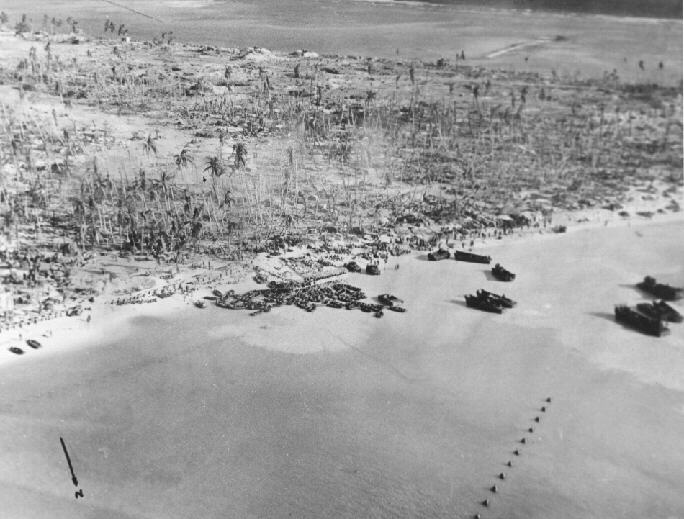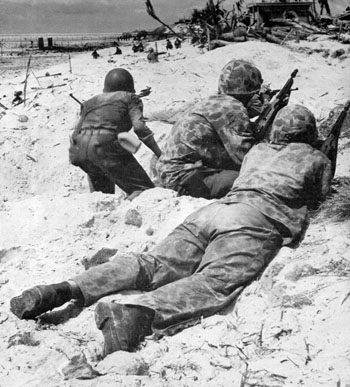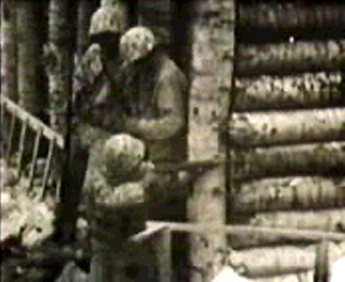During World War II Carroll served in the U.S. Marines Corps and attained the rank of Sergeant with the 8th Marines. He fought in and survived the battle of Guadalcanal which was the first major offensive launched by Allied forces against Japan in World War II.
After Guadalcanal Walker and the Marines were taken to New Zealand where they had a chance to rest and relax for a short time before they were re-supplied with troops and equipment and continued training in preparation for their next battle.
The next battle for the 8th Marines was the invasion of Tarawa fought from November 20 to November 23, 1943. The invasion of Tarawa was the second major offensive launched by the Allied forces against Japan and it was the first time that the United States faced serious Japanese opposition to an amphibious landing.
Tarawa was defended by approximately 3,000 elite Japanese marines and approximately 1,000 Japanese Seebees. The Japanese were well entrenched in numerous pillboxes throughout the island, they were also well-supplied, heavily armed, and well prepared for when the U.S. Marines attacked. The Japanese defenders fought almost to the last man (17 Japanese were captured) and exacted a heavy toll on the US Marines (1,687 Marines and sailors killed and 2,296 wounded).
Sergeant Walker was assigned to B Company of the 1st Battalion 8th Marines. In the early morning of November 21, 1943 Companies A and B of the 1/8 Marines were loaded into Higgins boats and headed for the Red 2 beachhead on Tarawa. This was the second day of the battle and the Red 2 beachhead had not been fully secured. Companies A and B were ordered to secure the beachhead. What the Marines did not know was that during the night of November 20th Japanese defenders had reestablished a number of machine gun nests in disabled amtracs around the beachhead as well as in the steamer ship "Niminoa" that had been scuttled near the beach. All of the machine guns were focused on the Red 2 beachhead.
As the Higgins boats were approaching the Red 2 beachhead they became hung up on a large coral reef. Consequently, the Marines had to climb out of the boats and wade across the reef in waist to chest deep water toward the beachhead. As they were wading in the water heading toward the beachhead they came under immediate and intense heavy fire from the machine gun nests in the disabled amtracs and the scuttled "Niminoa".
Many of the Marines in Companies A and B were hit by the intense machine gun fire. One of the Marines wounded by the machine gun fire was Sergeant Carroll Walker. Several Higgins boats that were not hung up on the large coral reef immediately began to take aboard wounded Marines and carry them back to the ships. Sergeant Walker and 44 other wounded Marines were rescued and placed aboard a Higgins boat commanded by Lt. Edward Albert Heimberger, a US Navy officer. Lt. Heimberger came under the same heavy intense fire as the Marines he was rescuing.
All of the wounded Marines were brought to the USS Schroeder, a destroyer. Sadly, when the Higgins boat arrived at the USS Schroeder Sergeant Walker was pronounced dead. He was buried at sea from the USS Schroeder in the vicinity of 01-26 N and Long. 172-56E.
For his actions at Tarawa for rescuing wounded Marines under intense heavy enemy machine gun fire Lt. Edward Albert Heimberger was awarded the Bronze Star with Combat "V". During the battle he had made three separate trips rescuing a total of 70 wounded Marines. After the war Lt. Heimberger continued doing what he did prior to his enlistment in the US Navy and that was acting in Broadway stage productions. He also became a prolific character and movie actor, and would later star in the TV series "Green Acres". Lt. Edward Albert Heimberger's stage name was Eddie Albert.
Thanks to North Des Moines High School Wall of Honorhttp://nhwallofhonor.com/pages/textwalkercarrollfrancis1940.html




Send an Email:
copyright 2010 T.O.T.W.
Created 11 August 2007 Updated 24 November 2010

